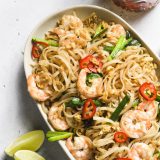Flames rip and tear, stretching above the blackened edges of Aon Apilak Plurksawet’s carbon steel wok, sending raging tongues of orange toward his face as he jostles, bangs and slams the pan above the heat. His eyes are closed beneath the brim of his black leather cowboy hat, his head gently bobbing and swaying to a melody lost in the clanging of his cooking.
Around him is darkness, spliced by mini floodlights above his head illuminating the cooking surface of his cart. The steamy night air is rich with chili, smoke, soy and fish sauces, the streetside perfume of Bangkok. Noodles, shrimp and sprouts fly violently about the wok, Plurksawet maneuvering it by a single charred and beaten wooden handle.
The intensity of his cooking explains his shop’s moniker: Pad Thai Narok Taek, also known as Mad Man Pad Thai. His manner with the wok verges on abusive, destroying five a week, sometimes as many as 25 a month. Laughing about his standing order for replacements, he holds up a misshapen oblong wok, charred black, cracked and split from edge to core.
Diners cluster at plastic tables on the sidewalk around his cart. Others find space in his “dining room,” an open-face alcove across from him, its orange and brown walls hung with guitars that during breaks in cooking he will pull down to strum Metallica. Icy bottles of Singha beer are delivered by boys working at a shop down the street.
Plurksawet’s cart is jammed with the ingredients—buckets of eggs, baskets of rice noodles and sprouts, bowls of shrimp and sauces—needed for the only four dishes he serves, all of them iterations of Thailand’s national and eponymous dish—pad Thai. And his is some of the best in the city, his priciest offering going for 105 baht per plate, or about $3.
Sometimes he cracks an egg directly onto the other ingredients, scrambling it as stir-fry coalesces as both verb and noun. Sometimes he first cooks the egg as a paper-thin crepe he’ll later use to wrap the pad Thai in a bundle. Regardless, every version always is prepared in a shroud of smoke, the value of which I wouldn’t understand until much later.
With his wife at the register, toddler son playing at her feet, and his niece and nephew prepping ingredients, Plurksawet will serve as many as 400 plates a night. When I taste it, I understand why the crowd.
With a shower of peanuts and chili flakes, a tangle of noodles and sprouts, a sauce as rich as it is sweet and tangy, and a finishing squeeze of lime and sprinkle of pickled fresh chilies, his pad Thai is a wonder of tastes and textures, a flavor bomb that is balanced and ... demanding. You can’t stop eating it.
The secret, he says, is not his abrasive cooking style. It’s his sauce. “The typical Thai restaurant makes a sauce like a sauce,” he explains. “I make a sauce like a jam.” It would take me a week of eating countless plates of pad Thai across the city before I realized his approach would be the key to creating equally good pad Thai in an American home kitchen.
Floating markets fill the waterways with food.
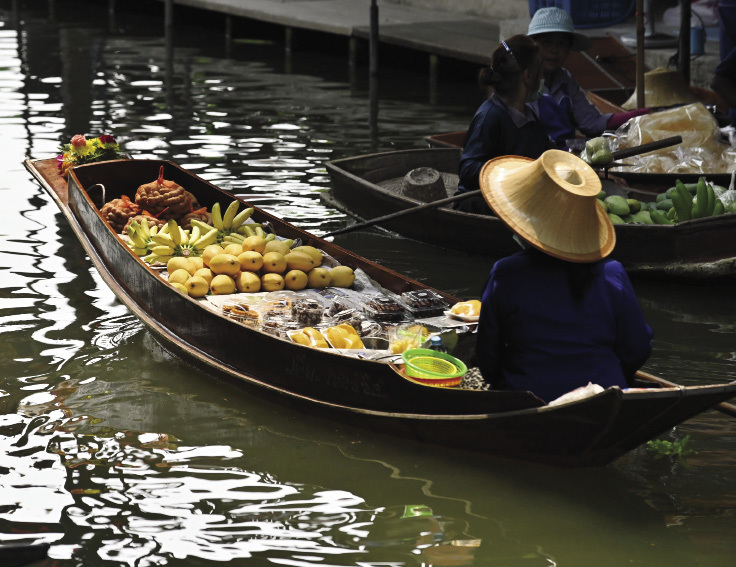
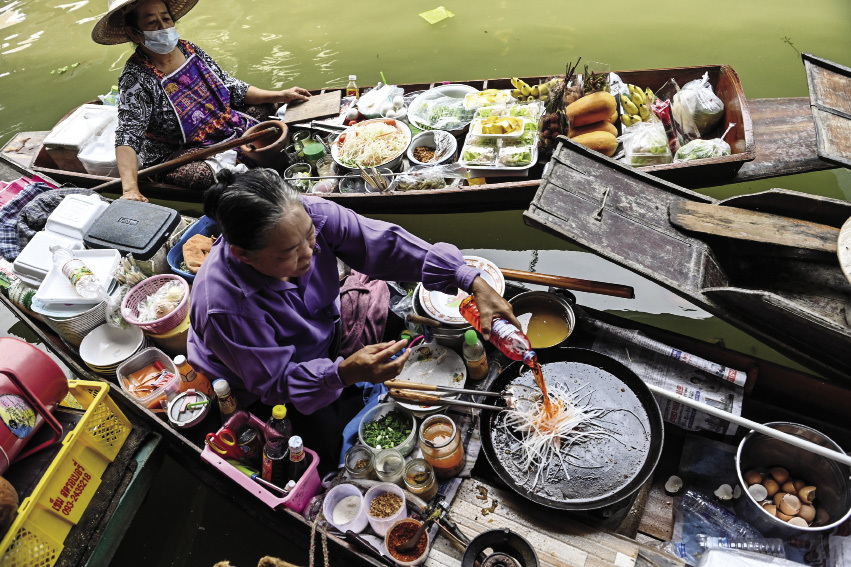
The Origins
At its simplest, pad Thai is a stir-fried rice noodle dish prepared in an intensely hot wok with a tamarind-based sauce. It always includes mung bean sprouts, crushed peanuts, some sort of chili heat and some sort of protein. But don’t kid yourself about the versions you’ve had in the U.S.; most are oily, sugary and adapted for a strip mall take-out palate.
Pad Thai is a relatively modern dish. Kind of. As we know it, the recipe dates back only to the late 1930s—the same time the nation known as Siam changed its name to Thailand—when a push to embolden Thai nationalism dovetailed with a rice shortage. Rice noodles were more affordable and plentiful, so the government encouraged their consumption.
Then-Prime Minister Plaek Phibunsongkhram often is credited with creating pad Thai around this time. He saw it as a one-dish, nutritionally rounded meal that embodied the best of Thai ingredients and spirit. More likely he simply popularized it, in part by sharing the recipe and encouraging street vendors to prepare it.
The roots of pad Thai go back much earlier, with ingredients and technique that are mainly Chinese. Stir-fried noodle dishes have long been part of that cuisine. Pad Thai built on those recipes, subbing ingredients considered more quintessentially Thai, including crushed dried chilies for heat, dried shrimp for salty-savory, and tamarind, a sour, pulpy fruit-like legume.
Whatever the backstory, by the end of World War II pad Thai was widely consumed across the country. In time, eggs and meat were added, and immigrants brought the dish with them around the world, cementing its role as Thai ambassador.
The Four Flavors
As I ate my way across Bangkok, the essence of great pad Thai came into focus. It starts with flavor, of course.
Tucked into a shopping plaza alongside a grocery shop and a Japanese ceramics store, Hot Shoppe Restaurant feels a bit like a diner decorated by your great-grandmother. They’ve been dishing up homestyle Thai cooking since 1970 and offered to walk me through their incredibly speedy take on pad Thai.
Cook Suwan Pimtatong has been stir-frying noodles at Hot Shoppe for 28 years, a tenure that telegraphs in her ease with the wok. She starts with a splash of safflower oil—something that can handle the heat. The shrimp go in and out in a flash, seared but not finished, then set aside. Then ground pork. A few seconds later, an egg is scrambled in.
Fresh rice noodles and a generous glug of sweet-and-savory tamarind sauce go next. The barely tender noodles absorb the sauce and all that flavor, softening and seasoning. Bare minutes later, chives, sprouts, chili flakes and crushed peanuts join them. Not five minutes has passed and the shrimp are returned to the wok, just long enough to cook through. Done.
With such simple ingredients, it shouldn’t taste nearly as complex as it does. It’s all about balance, Pimtatong says. A proper pad Thai must satisfy four flavors—sweet, salty, spicy and sour—each provided by a different classic ingredient. The sweet is palm sugar, a heavy sweetener rich with caramel-molasses notes. Red pepper flakes deliver the spice. Sour is tamarind.
All fine. It was the salty that troubled me. Tradition calls for dried shrimp, an umami-
intense ingredient many American home cooks would be challenged to source. But its flavor is so distinct and defining of pad Thai, could we make a great version without it? My answer, it turns out, was found in history.
Pimtatong doesn’t use dried shrimp. Prior to the push some 80 years ago to use Thai ingredients, most related recipes relied instead on a blend of two Chinese sauces, soy and oyster. Dried shrimp replaced them as part of the effort to make stir-fried noodles more Thai-centric. But Pimtatong prefers the sauces because the noodles better absorb their flavor.
Rice noodles have a lightly chewy texture and an almost neutral taste that readily absorbs flavors. Made from rice flour and water, they are common to soups, salads and stir-fries in East and Southeast Asia, particularly Vietnam and Thailand. The noodles can range from quite thin and wiry (often called rice vermicelli or maifun) to thick and up to ½ inch wide, the latter sometimes called rice sticks. Rice vermicelli are used in Vietnamese summer rolls, Singapore curry noodles and Filipino pancit bihon. Larger rice sticks mostly show up in stir-fries and soups. In Asia, the noodles are available both fresh and dried; dried is most common in the U.S. To prepare dried rice stick noodles for stir-frying, they usually first are softened by soaking in hot water. For pad Thai, we found most rice stick noodles measuring about ¼ inch wide worked well, but we favored a few: Asian Best, Erawan Brand and Three Ladies Brand, all in medium size and sold in 14- or 16-ounce packages, are in many supermarkets. If not available, rice noodles from Thai Kitchen or A Taste of Thai are good, too. We soaked the noodles for about 30 minutes, but no more than an hour (longer caused them to break apart during cooking). Adding the noodles in batches, as we do, minimized the need to add water during cooking. In most cases, the sauce was sufficient liquid, but you still may need to add a few tablespoons.
The Texture
Balance doesn’t stop with flavor. Contrasting textures are key, too. I learn this, oddly, from a woman in a boat.
Damnoen Saduak Floating Market is the heart of a tiny town 100 kilometers west of Bangkok. Piapha Tmvichit has been cooking pad Thai there for 30 years. And like most of the vendors, she does business from a narrow canoe-like boat that glides along a series of slow-flowing canals. Each boat has a different offering—produce, meat, fully cooked meals.
The boats are cooperative, sometimes three or four deep from the shore, the vendors passing food and money hand to hand as transactions are made. Tmvichit’s boat is loaded. At the front, a propane tank on its side. In the center, a shallow wok over a gas burner, buckets of eggs, jars of crushed peanuts, chili flakes, bags of noodles, all arranged around her.
Tmvichit assembles my pad Thai with ease and speed following a now-familiar pattern. But it’s her focus on a new-to-me detail that gets my attention. This is no haphazard endeavor. Each ingredient is tested for its texture and added in a determined order intended to produce a particular mouthfeel in the finished dish.
Shrimp, in and out of the wok quickly to be firm, not rubbery. Noodles that go in almost perfectly dry to better soften as they absorb sauce, just enough to be tender-chewy without becoming mushy or sticking together. Chili flakes and peanuts that sizzle and crisp in the oil. Egg barely cooked to be pillowy. Sprouts added just at the end to stay crisp, almost crunchy.
The result is a symphony of textures. Crisp and tender, chewy and crunchy, all playing off one another. The backbone of it all is those noodles, traditionally hydrated in warm water before cooking. Too long and they fall apart. Not long enough and they are unpleasantly crunchy. Tmvichit is a master of this timing. No small feat in a dish that comes together in minutes.
Intensely fruity and with a potent sweet-sour flavor, tamarind is widely used across Latin America, India and Southeast Asia to add tangy, bright notes to noodle dishes, such as pad Thai, as well as sauces and chutneys. While some shops sell fresh tamarind, which look like long brown seed pods—it technically is a legume—the pulpy fruit is more widely available as a jarred concentrate or in semi-dried blocks of pulp; we prefer the latter for its cleaner, stronger flavor. Concentrates left our pad Thai tasting flat and looking muddy. To use pulp, soak chunks of it in hot water until softened, about 10 minutes. Then press it through a mesh strainer to separate the pulp from the inedible fiber and any seeds (note that even packages labeled seedless often contain seeds). When shopping for tamarind pulp, look for packages that feel soft and flexible, with an even light brown color. Tamarind that’s very dark brown and stiff is dried out and won’t taste as fresh. Our favorite was Thailand brand Tamarin Me Chua.
The Wok Hei
One element remained elusive. Wok hei, the ephemeral yet defining characteristic of high-heat wok cooking, sometimes called the “breath of the wok.” Regardless of the many variations, each time I’d seen pad Thai prepared it began the same: an empty wok set over a blazing flame until smoke roiled and rolled upward. Only then did cooking begin.
The result is a flavor that verges on grilled or charred, deliciously so. Everything tastes a bit deeper and richer. It’s a flavor hard to replicate without the monstrously strong burners used by the pros. Can you make a reasonably good pad Thai without achieving wok hei? Of course. But so transcendent is its taste, it nonetheless is a goal worth pursuing.
Which is how I met Gigg Kamol, Thailand’s Iron Chef and owner of several Bangkok restaurants, including Phed Mark. He tried for ages to devise an approach to wok hei that worked on low-BTU home stovetops. Without success. That is, until he reconsidered his goal. Rather than chase the smoke, he went after the flavor the smoke leaves behind.
That is, an intensity. As in most stir-fried noodle dishes, much of the flavor of pad Thai comes from the sauce. Kamol discovered that if you pour the sauce directly onto the surface of the wok—rather than on the ingredients in it—the sauce reduces and its sugars caramelize, producing significantly richer, deeper flavor.
This is when things came together. Though with his intense flames he hardly needed it, this is precisely what “Mad Man” Plurksawet was talking about when he said he makes sauces that verge on jams. He opts to cook them down in advance to keep things moving at the speed his shop needs, but the effect is the same. This also helped explain why his pad Thai was by far the best I had in Thailand. Flavor built on top of flavor.
When we experimented with this approach, not only did it deliver delicious results, it was enhanced by the lesson we’d learned at Hot Shoppe Restaurant. The sugars in the oyster sauce they’d encouraged us to use in place of dried shrimp doubled down on the caramelization we got from Kamol’s technique.
The result? A rich, deeply seasoned pad Thai at home. No clanging or towering flames needed.
The Secret Is in the Sauce
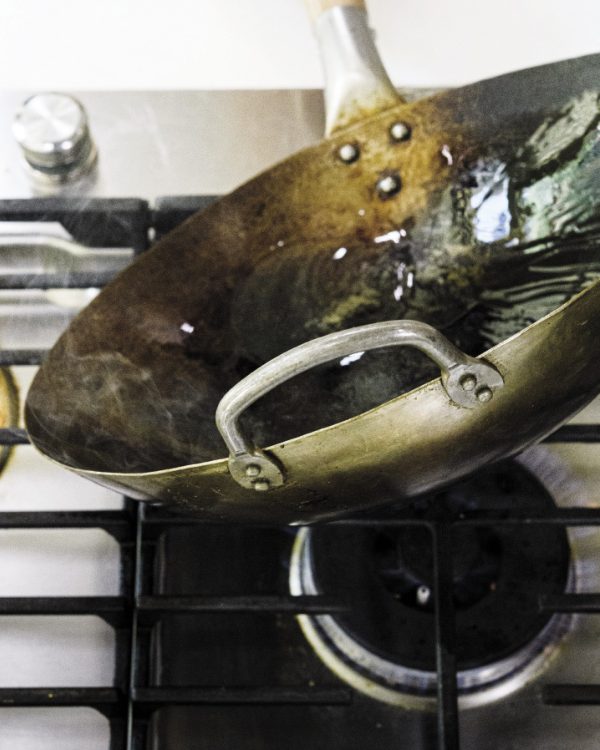
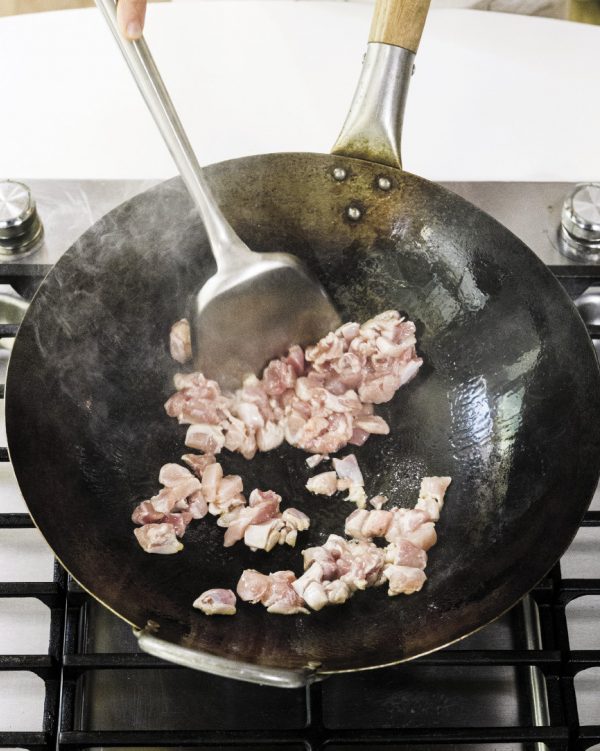
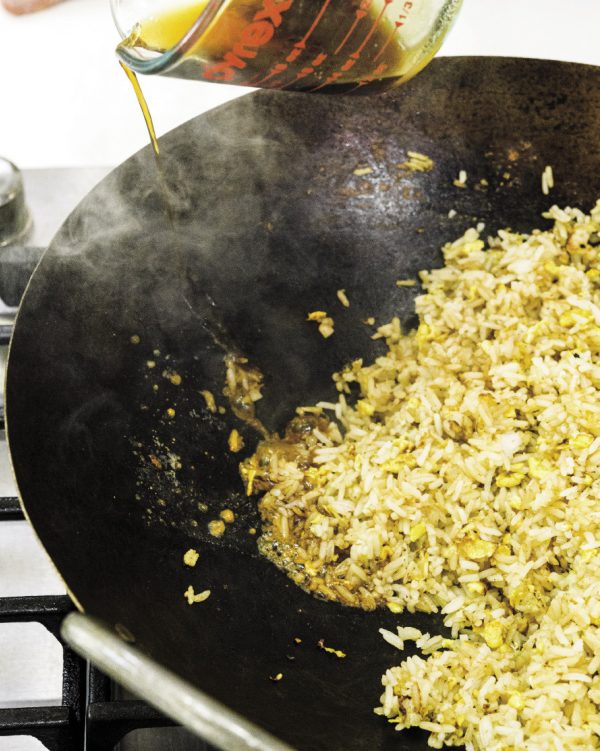
1. Lightly coat the surface of the wok with a high smoke point oil (we prefer grapeseed or safflower oil). Heat over high, rotating the wok now and then, until the wok is smoking.
2. Add protein (meat, seafood or tofu) and cook until water releases and evaporates. Seafood often should be only partly cooked, then set aside and returned later in cooking.
3. Drizzle the sauce around the side of the wok, not directly onto the ingredients. This maximizes its contact with the hot surface and allows it to sizzle and reduce as it drips.
Simultaneously ethereal and pronounced, wok hei refers to the distinctive flavor imparted to food during high-heat cooking in a wok. Chinese American cookbook author Grace Young defines it as “breath of a wok,” though “wok energy” is a more literal translation. Descriptions of wok hei flavor range from smoky or caramelized to grilled and charred.
It’s a style of cooking rooted in Cantonese cuisine, though it is found across Southeast Asia and—thanks to immigration during the 1800s—many American Chinese restaurants. A host of factors contribute to wok hei, but two are particularly notable: the carbon steel woks and the high-octane gas burners found in most restaurants.
Those burners, which can reach more than 150,000 BTUs, generate intense heat quickly. The carbon steel woks, like cast-iron skillets, are seasoned with a coating of polymerized oils, creating a naturally nonstick surface. The interaction of the heat and oil-coated pan produces smoke and speedy caramelization that coat food as it cooks.
But many home cooks struggle to reproduce this effect, even in China. Home stovetop gas burners often max out at 18,000 BTUs, and few cooks have well-seasoned carbon steel woks. Hacks to replicate this abound, but many are cumbersome.
Curious whether wok hei is a goal worth pursuing, we sought out Gigg Kamol, Thailand’s Iron Chef and owner of several Bangkok restaurants, including Phed Mark, which is famous for its pad kra pao, a spicy basil and pork stir-fry in which wok hei is a key ingredient unto itself.
He prepared side-by-side versions of his signature dish—one traditionally, the other over lower heat to mimic home cooking conditions. The low-and-slow version was undeniably delicious, but the wok hei sample—which began with billowing smoke rising from the wok—was rich with savory, smoky flavor that edged toward char, but never tasted of burnt, just depth.
Kamol has spent years trying to replicate wok hei with home cooking equipment. But even letting the pan sit for prolonged periods over high heat wasn’t enough. The empty pan would smoke, but as soon as ingredients were added, the pan cooled and never was able to recover to a sufficient temperature.
The problem was in trying to replicate restaurant equipment conditions. Success came when Kamol instead worked to duplicate not the conditions, but the flavors. This meant adding ingredients in ways that maximize caramelization.
He calls it saucing the wok, not the food. Pouring sauce over food reduces its contact with the wok, limiting its contact with heat. But when he pushed the food to one side and drizzled the sauce directly on the surface of the pan, it sizzled, caramelized and developed deeper, richer flavor.
To further enhance this effect, he also cooks proteins first to give them time to release and cook off any water, which would dilute the other flavors.
We used his technique for our pad Thai and loved the results. But the same approach works for all manner of stir-fry where the smoky richness of wok hei is desired.
